![]()
![]()
![]()
Use LEFT and RIGHT arrow keys to navigate between flashcards;
Use UP and DOWN arrow keys to flip the card;
H to show hint;
A reads text to speech;
311 Cards in this Set
- Front
- Back
|
Increase Echo Time; what is the affect on SNR? |
Decrease |
|
|
Increase Signal Averages; what is the affect on SNR? |
Increase |
|
|
Increase in Receiver Bandwidth; what is the affect on SNR? |
Decrease |
|
|
What is TR’s effect on resolution? |
No effect |
|
|
TR time to completely eliminate T1contrast? |
More than 3 sec |
|
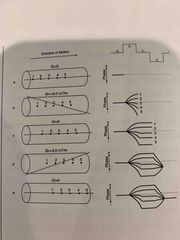
Front (Term) |
Evolution of phase for moving protons |
|
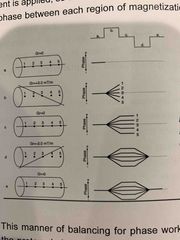
Front (Term) |
Evolution of phase for stationary protons |
|
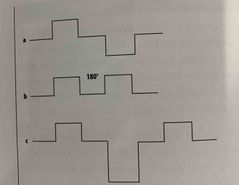
Front (Term) |

Back (Definition) |
|
|
Larmor Equation |
f=¥/2 |
|
|
Increase Amplitude(stronger RF) Has what effect on transverse energy? |
Increases |
|
|
Increase TE has what effect on T2 contrast |
Increases |
|
|
Increase TE has what effect on SNR? |
Decreases |
|
|
If contrast increases what happens to SNR |
Decreases |
|
|
An increase SNR has what effect on spatial resolution? |
Decrease resolution |
|
|
Increasing FOV has what effect on SNR and spatial resolution? |
Increase in SNR; decrease in Spatial Resolution |
|
|
Increase in FOV increases what artifact? |
Ringing artifact |
|
|
How does an increase in phase effect scan time? |
Increases |
|
|
Small FOV makes anatomy larger or smaller? |
Larger; acts like a zoom |
|
|
Rectangular FOV has what effect on spatial resolution? |
None; no effect |
|
|
Increasing Rectangular FOV increases what? |
Amount of anatomy imaged; SNR; scan time |
|
|
Increasing FOV does what to pixel size? |
Increases it |
|
|
What effect does increasing pixel size have? |
Increased pixel size increases amount of signals per pixel |
|
|
What effect does increasing pixel size have? |
Increased pixel size increases amount of signals per pixel |
|
|
Increased pixel size increases amount of signals per pixel which has what effect on SNR and spatial resolution? |
Increasing SNR; decreasing spatial resolution |
|
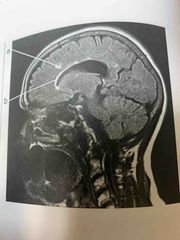
What kind of projection is this? |
FLAIR |
|
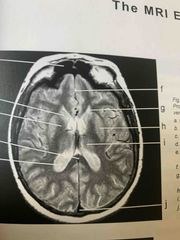
What kind of projection is this? |
proton density |
|
|
T1 images are most sensitive to what age group? (Peds) |
Less than 1 |
|
|
T1 images are most sensitive to what age group? (Peds) |
Less than 1 |
|
|
T2 weighted images are most sensitive to what age group? (Peds) |
Ages 1 and 2 |
|
|
In a 2 year old white matter will be? |
Hypointense |
|
|
Which of the dephasing mechanisms is NOT rephased by a 180 pulse? |
Spin-spin interactions |
|
|
Which of the dephasing mechanisms is NOT rephased by a 180 pulse? |
Spin-spin interactions |
|
|
Gyromagnetic Ratio |
42.6 |
|
|
Larmor equation |
F=(¥/2pi)B |
|
|
After a 90 pulse if three 180 pulses are applied to generate 3 echoes, what is responsible for the 3rd echo being smaller? |
Spin spin interactions |
|
|
Long T2 relax time= |
Bright signal |
|
|
Long T2 relax time= |
Bright signal |
|
|
Short T1 relax time= |
Bright signal |
|
|
On a T2 of the brain is white matter or gray matter darker? |
White(longer TE) |
|
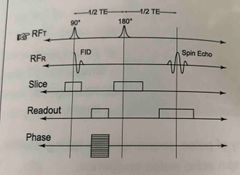
Front (Term) |
Conventional Spin Echo |
|

Front (Term) |
Fast Spin Echo |
|
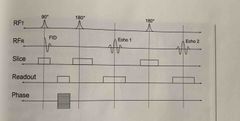
Front (Term) |
Dual contrast Spin Echo |
|
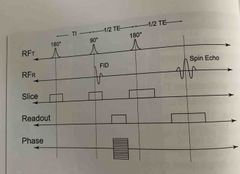
Front (Term) |
Inversion Recovery |
|
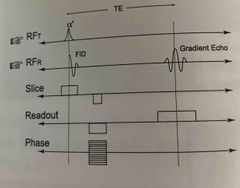
Front (Term) |
Gradient Echo |
|
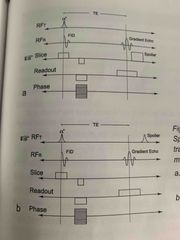
Front (Term) |
Spoiled Gradient Echo- can use RF or gradient to reduce residual magnetization that was in transverse plane. |
|
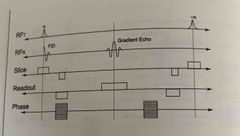
Front (Term) |
Steady state gradient echo- adds an extra gradient to balance phase. |
|

Front (Term) |
EPI (Echo Planar Imaging) |
|
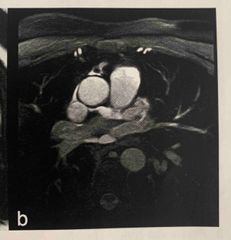
Front (Term) |
left Coronary Artery |
|
|
How to reduce susceptibility artifacts? (4) |
1. Use multi shot EPI instead of single shot 2. Shim 3. Thin slices 4. Short TE |
|
|
2D scan time |
TR x Signal Avg x lines in matrix/echoes per TR |
|

A? |
Posterior cerebral artery |
|
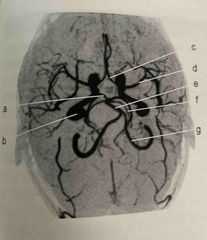
B? |
Internal carotid artery |
|

C? |
Anterior cerebral artery |
|
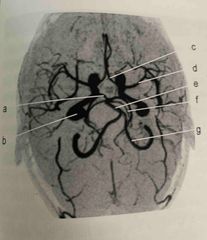
D? |
Middle cerebral artery |
|
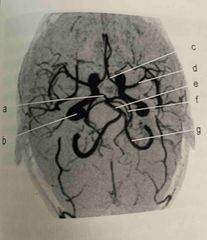
E? |
Basilar artery |
|

F? |
Pons and cerebellar artery |
|
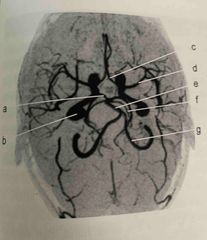
G? |
Vertebral artery |
|
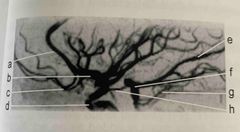
A? |
Middle cerebral artery |
|
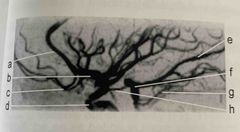
B? |
Circle of Willis |
|

C? |
Anterior cerebral artery |
|
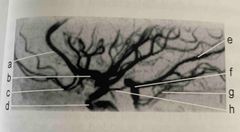
D |
Internal carotid artery |
|

E |
Posterior cerebral artery |
|
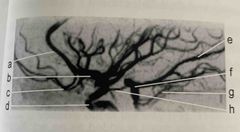
F? |
Basilar artery |
|
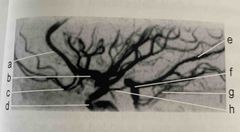
G |
Cerebellar artery |
|
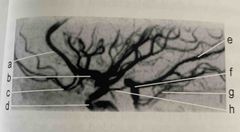
H |
Posterior communicating artery |
|
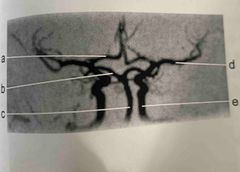
A |
Anterior cerebral artery |
|

B |
Posterior cerebral artery |
|
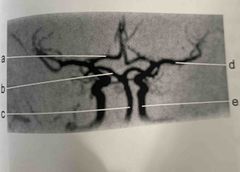
C |
Basilar artery |
|
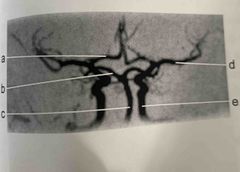
D |
Middle cerebral artery |
|
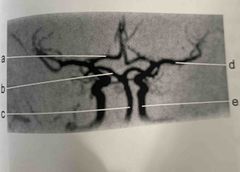
E? |
Internal carotid |
|
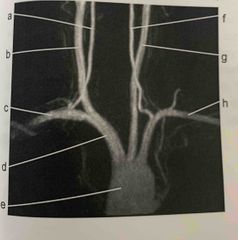
A |
Rt vertebral artery |
|
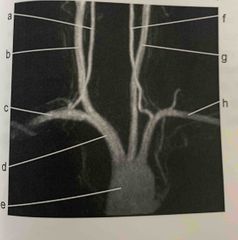
B |
Rt common carotid artery |
|
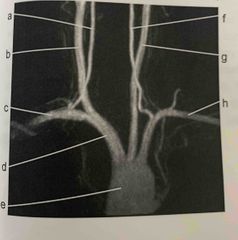
C |
Rt subclavian artery |
|
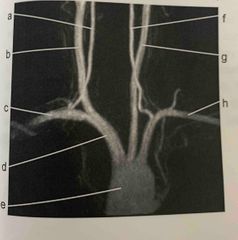
D |
Brachiocephalic artery |
|
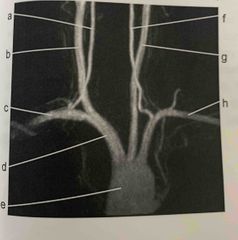
E |
Aortic arch |
|
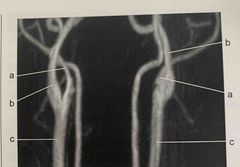
A, B & C |
A) external carotid art. B) internal carotid art. C) common carotid art. |
|

A, B, C & D |
A) aortic riot B) rt coronary artery C) lt circumflex artery D) lt ventricle |
|
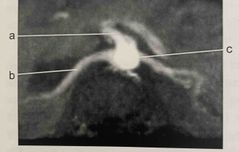
A, B, C |
A) superior messenteric art B) renal C) abdominal aorta |
|
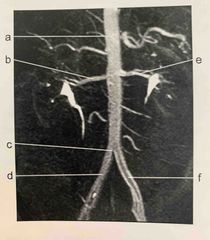
A, B, C, & D |
A) abdominal aorta B) rt renal art C)bifurcation D) rt common iliac art |
|
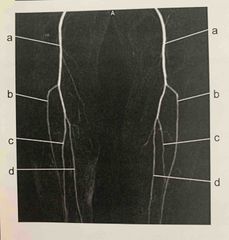
A, B, C & D |
A) popliteal B) anterior tibial art C)peroneal art D) posterior tibial art |
|
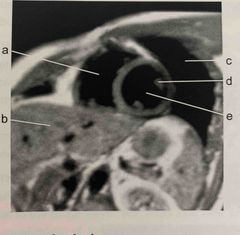
Front (Term) |
A) rt ventricle B) liver C) lung D) papillary muscle E) lt ventricle |
|
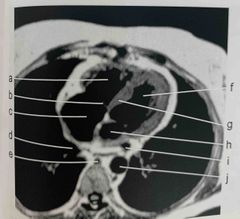
A, B, C, D, E |
A) rt ventricle B) tricuspid valve C) rt atrium D) inferior vena cava E) azygous vein |
|
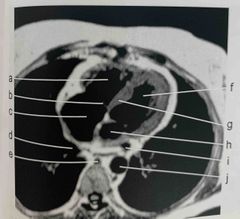
F, G, H, I, J |
F) left ventricle G) ventricular septum H) left atrium I) coronary sinus J) descending aorta |
|
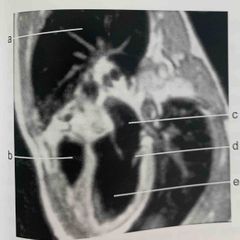
A-E |
A) lung B) rt ventricle C) left atrium D) mitral valve E) left ventricle |
|
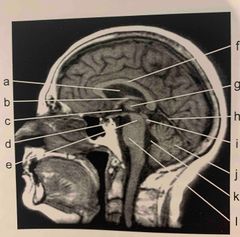
A, B, C |
A) lateral ventricle B) fornix C) third ventricle |
|

D,E,F |
D) pituitary gland E) peduncle F)corpus callosum |
|

G, H, I |
G) thalamus H) tentorium I) quadrigeminal plate |
|
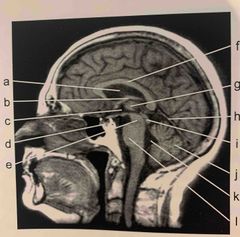
J, K, L |
J) cerebellum K) fourth ventricle L) pons |
|
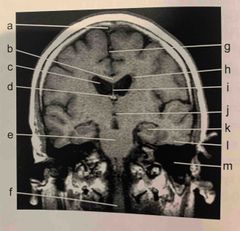
A, B, C |
A) sagittal sinus B) corpus callosum C) lateral ventricle |
|

D, E, F |
D) fornix E) pons F) spinal cord |
|
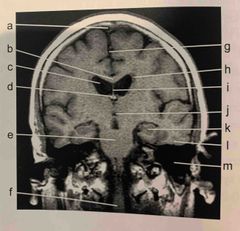
G, H, I |
G) falx cerebri H) caudate nucleus I) septum pellucidum |
|
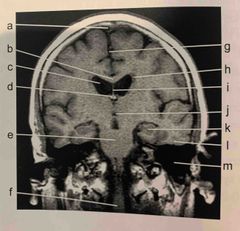
J, K, L |
J) aqueduct K) amygdala L) hippocampus |
|
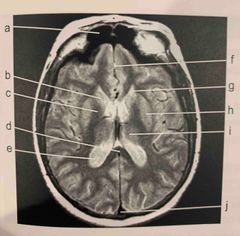
A, B, C |
A) frontal sinus B) caudate nucleus C) internal capsule |
|
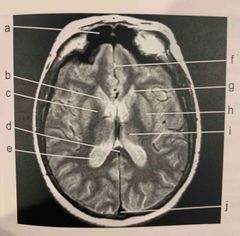
D, E, F |
D) corpus callosum E) anterior horn of lateral ventricle F) falx cerebri |
|
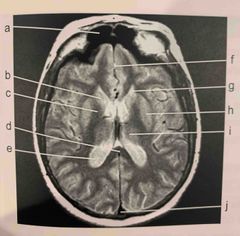
G, H, I, J |
G) lateral ventricle(anterior horn) H) putamen I) thalamus J) superior sagittal sinus |
|
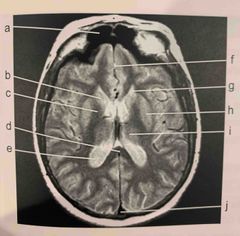
A, B, C |
A) frontal sinus B) caudate nucleus C) internal capsule |
|
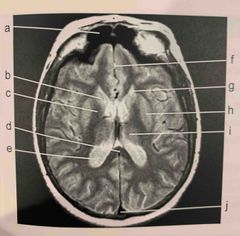
D, E, F |
D) corpus callosum E) posterior horn of lateral ventricle F) falx cerebri |
|

G, H, I, J |
G) lateral ventricle(anterior horn) H) putamen I) thalamus J) superior sagittal sinus |
|
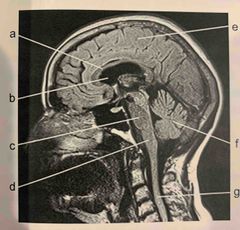
Where is medulla oblongata? |
D |
|
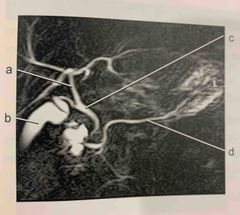
A, B, C, D |
A) common hepatic B) gallbladder C) common bile duct D) pancreatic duct |
|
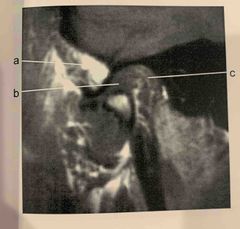
A, B, C |
A) articular tubercle B) articular disk C) lateral pterygoid muscle |
|

A, B, C, D |
A) clavicle B) supraspinatus muscle C) labrum D) glenoid |
|
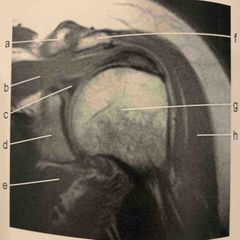
E, F, G, H |
E) subscapularis muscle F) acromion G) humerus H) deltoid muscle |
|
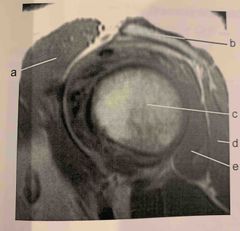
A, B, C, D, E |
A) deltoid B) scapula C) humerus D) deltoid E) teres minor muscle |
|
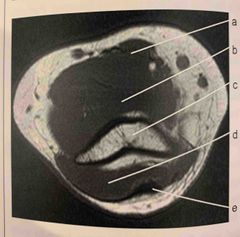
A, B, C, D, E |
A) bicep muscle B) brachialis muscle C) humerus D) tricep muscle E) tricep tendon |
|
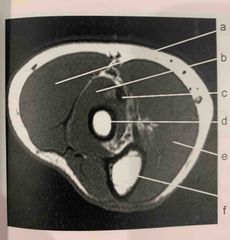
A, B, C |
A) carpi radialis brevis and longus muscles B) supinator muscle C) bicep tendon |
|

D, E, F |
D) radius E) carpi ulnaris muscle F) ulna |
|
|
Fast Spin Echo |
Initial 90 RF followed by 180 RF to rephase. Many echoes collected during a single TR. |
|
|
How are echoes in a FSE placed in the raw data? |
Not sequential order. Ordered to achieve greatest contrast. |
|
|
Conventional spin echo |
90 RF W/ 180 to phase. 1 echo to raw data per TR. |
|
|
Conventional spin echo |
90 RF W/ 180 to phase. 1 echo to raw data per TR. |
|
|
Dual Contrast Spin Echo |
Allows you to acquire additional echo @ second TE time. Echo train divided into T2 & PD |
|
|
Dual contrast fast Spin echo |
Same as DCSE but needs twice as many echoes. |
|
|
STIR |
T1 relaxation through null point = no signal |
|
|
FLAIR |
Very long TI (2000 ms) TR of 6-9 sec USED IN conjunction with FSE |
|
|
FLAIR |
Very long TI (2000 ms) TR of 6-9 sec USED IN conjunction with FSE |
|
|
What is FLAIR good for? |
MS METS |
|
|
Echoes in the center of the raw data contribute more.... |
Contrast info |
|
|
Echoes in the center of the raw data contribute more.... |
Contrast info |
|
|
Echoes in the periphery of the raw data contribute more |
Resolution info |
|
|
Ways to reduced susceptibility artifacts |
Shim Thin slices Short TE |
|
|
Volumetric coil |
Surrounds anatomy being imaged. |
|
|
Volumetric coil |
Surrounds anatomy being imaged. |
|
|
Sum of magnetic effects of all protons exposed to the magnetic field |
Net magnetization |
|
|
Phenomenon of protons constantly gaining and shedding energy |
Energy state transition |
|
|
Equation states resonant frequency of a population of a specific nucleus not only depends on the main magnetic strength but also on a mathematical constant that is unique to each nucleus. |
Larmor frequency |
|
|
Mathematical constant in larmor equation |
Gyro magnetic ratio |
|
|
RF transmitted to pt to tilt net mag of protons as they relax, MR signal is generated |
Precessional frequency |
|
|
Phenomenon permits efficient transfer of energy from one object to another |
Resonance |
|
|
Angle between starting position of net magnetization and resultant position after RF application |
RF Flip Angle |
|
|
RF flip angle is determined by |
1) amplitude 2) duration |
|
|
Signal decay that occurs as a result of the dephasing of the transverse magnetization |
Free Induction Decay |
|
|
The rate at which an event repeats itself |
Frequency |
|
|
Whether certain events are synchronized with each other |
Phase |
|
|
Transfer of energy only occurs if the frequency of the transmitting system is equal to the receiving system |
Principle of resonance |
|
|
The broader the range of frequencies the _____ the slice |
Thicker |
|
|
An increase in transmitter bandwidth has what effect on slice thickness |
Increase |
|
|
Higher gradient amplitude = _____ slice |
Thinner |
|
|
Data file that contains each collected echo. Represents a mathematical domain |
Raw data |
|
|
Data file that contains each collected echo. Represents a mathematical domain |
Raw data |
|
|
Mathematical domain that contains collected echoes |
K-space |
|
|
Mathematical calculation applied to the raw data |
Fourier transform |
|
|
Mathematical calculation applied to the raw data |
Fourier transform |
|
|
Breaks down all frequency and phase components and converts it in to anatomical data |
Fourier transform |
|
|
TR is equal to ____ in the matrix |
Phase lines |
|
|
MR Console does what 4 tasks? |
1. Pulse sequence parameters 2. Starts scans 3. Post processing 4. Filming images |
|
|
MR Console does what 4 tasks? |
1. Pulse sequence parameters 2. Starts scans 3. Post processing 4. Filming images |
|
|
Translates commands into the systems language |
Host computer |
|
|
Responsible for the timing and correct performance of each system component once the sequence has been started |
Pulse sequence controller |
|
|
Dictates when and how much gradient power is needed. |
Pulse sequence controller |
|
|
Dictates when RF must be transmitted & for what duration of time. |
Pulse sequence controller |
|
|
Sends signal to RF power amp which is converted to analog signal |
Pulse sequence controller |
|
|
Detects tiny currents |
RF Antannae |
|
|
Greatly increases the echoes |
Pre amplifier |
|
|
Samples the analog signal |
Sample and hold component |
|
|
Filters the amplified and digitized echoes |
Filter |
|
|
Filters the amplified and digitized echoes |
Filter |
|
|
Fourier calculates the echoes from raw data file into an image in which component |
Array processor |
|
|
If a charged particle is moved a distance along a path, a magnetic field will be generated perpendicular to the direction of the particles motion |
Basic law of electromagnetism |
|
|
Coils of wire through which a current passes |
Electromagnets |
|
|
Polarity of the magnet is determined by |
The direction of the current flow in the coil |
|
|
The process by which magnetic field inhomogeneities are greatly reduced |
Shimming |
|
|
Where is the x gradient located? |
Sides of the cylinder |
|
|
Where is the y gradient located |
Top and bottom |
|
|
Where is the y gradient located |
Top and bottom |
|
|
Where is gradient z located |
Ends of the cylinder |
|
|
Percent of time gradient is applied at a specific amplitude |
Duty cycle |
|
|
Percent of time gradient is applied at a specific amplitude |
Duty cycle |
|
|
Combines gradient rise time and amplitude into a single parameter |
Slew rate |
|
|
Increased gradient amps = |
1. Thinner slices 2. Smaller FOV 3. Shorter TE 4. Shorter scan time 5. More slices |
|
|
Any magnetic change occurring near a neighboring conductive material will cause a voltage to be induced across the neighbor as well |
Faradays Law |
|
|
Range of frequencies sampled within the MR signal |
Receiver bandwidth |
|
|
Receiver bandwidth affects what? |
SNR and severity of chemical shift |
|
|
Process by which electronic parameters within the coil are varied so that the coils transmitting and receiving abilities are matched to size and shape of anatomy in the coil |
Tuning |
|
|
4 types of coil geometry |
1. Volumetric coils 2. Surface coils 3. Array coils 4. Quadrature coils |
|
|
Keeps RF inside magnet room and unwanted radio signals from entering the room |
Faraday or RF shielding |
|
|
Series of RF and gradient pulses used to disturb and manipulate net magnetization orientation and spatially encode info from echoes |
Pulse sequence |
|
|
Charts time at which the RF energy is transmitted and received and the time and duration of each gradient pulse |
Pulse sequence timing diagram |
|
|
Requires high gradient amps and slew rates |
EPI |
|
|
Requires high gradient amps and slew rates |
EPI |
|
|
Precision of a measurement with respect to time |
Temporal resolution |
|
|
4 key influences on parameters |
1. SNR 2. Contrast 3. Spatial resolution 4. Scan time |
|
|
Increase TR does what to scan time? |
Increase |
|
|
Based primarily on concentration of hydrogen protons within the tissue |
PD |
|
|
Increased flip angle without exceeding 90 does what to SNR |
Increases |
|
|
Larger the flip angle does what to T1 contrast |
Decreases |
|
|
Flip angle which produces the best SNR for a given TR and tissue type |
Ernst angle |
|
|
Results from Fourier transform processing several mm of varying tissue contrast and displaying it as a single shade of gray |
Partial volume effect |
|
|
Increasing slice thickness does what to SNR |
Increases |
|
|
Increasing gaps between slices will... |
1. Decrease crosstalk 2. Increase anatomical coverage of the scan 3. Increases risk of missing important anatomy |
|
|
Increasing phase encoding steps will |
1. Decrease SNR 2. Increase spatial resolution 3. Increase scan time |
|
|
Increasing phase encoding steps will |
1. Decrease SNR 2. Increase spatial resolution 3. Increase scan time |
|
|
Increasing frequency steps will |
1. Decrease SNR 2. Increase SNR 3. Have no effect on time |
|
|
Increasing signal averages will |
1. Increase SNR 2. Increase scan time 3. Decrease motion artifacts |
|
|
Increasing receiver bandwidth |
Decreases SNR Decreases chemical shift Does not affect scan time |
|
|
2 disadvantages of SAT bands |
1. Increased SAR to pt 2. Reduction in the max number of slices |
|
|
Echoes are only collected during certain selected periods of the physiological cycle. |
Gating |
|
|
A particular event during the physiological cycle commences the collection of echoes which then continues through the entire TR |
Triggering |
|
|
Decreasing slice select gradient amplitude will have what effect on slice thickness |
Increased slice thickness |
|
|
Single picture element defined by intersection of frequency steps and phase steps |
Pixel |
|
|
FOV divided by Matrix |
Resolution |
|
|
3 fat suppression techniques |
1. Fat Suppressed Inversion Recovery 2. Spectrally Selective Fat suppressed inversion recovery 3. Spectral Fat Saturation |
|
|
Scan time reduction technique that maintains full square FOV |
Parallel imaging |
|
|
Enables manipulation of contrast to certain tissues |
Magnetization transfer contrast |
|
|
What interactions cause exchange of magnetization in some tissues? |
Dipole-dipole |
|
|
TR must be ____ when you add a SAT band |
Longer |
|
|
Blood flow that has a parabolic flow profile |
Laminar flow |
|
|
Blood flow that has a parabolic flow profile |
Laminar flow |
|
|
Velocity of protons in center of vessel is greater than at the vessel walls |
Laminar flow |
|
|
What kind of blood flow is usually distal to bifurcation and stenosis |
Turbulent flow |
|
|
Fairly slow blood flow; doesn’t vary much |
Veins |
|
|
Fairly slow blood flow; doesn’t vary much |
Veins |
|
|
Very rapid and pulsatile |
Arteries |
|
|
Inflowing protons are relaxed |
Magnitude effect |
|
|
Flowing protons accumulate phase |
Phase effects of flow |
|
|
Flow of vessel is mismapped in the phase direction giving the appearance of a dark vessel |
Signal void |
|
|
Phenomenon responsible for delineating blood from stationary tissue |
Inflow enhancement |
|
|
Multiple RFs knock out signal from stationary protons but the inflowing protons have not been influenced by RF meaning they haven’t been saturated |
Time of Flight MRA |
|
|
Multiple RFs knock out signal from stationary protons but the inflowing protons have not been influenced by RF meaning they haven’t been saturated |
Time of Flight MRA |
|
|
Pulse sequence used for Time of Flight MRA |
GRE |
|
|
Algorithm used to project brightest pixels onto a plane to generate an image of the region of interest |
Maximum Intensity Projection |
|
|
Algorithm used to project brightest pixels onto a plane to generate an image of the region of interest |
Maximum Intensity Projection |
|
|
When do we use a 2D TOF MRA |
Flow is slower; need to cover larger area |
|
|
When is 3D TOF MRA used |
Fast flow, tortuous vessels where fine resolution is required and when limited distance coverage will suffice |
|
|
Requires selection of separate, smaller volumes to ensure blood generates substantial amount of signal |
3D multivolume TOF MRA |
|
|
Used when blood is too slow to traverse entire volume before becoming saturated |
3D multivolume TOF MRA |
|
|
Used when blood is too slow to traverse entire volume before becoming saturated |
3D multivolume TOF MRA |
|
|
Lines seen in projection images at intersection of small volumes |
Venetian blind artifact |
|
|
Dependent upon phase shift in echo induced by flowing blood as it moves through equal and opposite gradients |
Phase contrast MRA |
|
|
Greater velocity of blood flow = _____ phase shift |
Greater |
|
|
In a Phase Contrast MRA which has brighter signal? Slower or faster velocity flow |
Faster; greater velocity= greater phase shift |
|
|
In a phase contrast MRA what are the larger gradient amps responsible for encoding? |
Slow flow |
|
|
Refers to amp of gradients and specifies flow velocity which will generate max signal intensity |
Velocity encoding value |
|
|
High velocity PCA |
90m/sec |
|
|
2 advantages of PCA |
1. Good visualization of Sm vessels, slow flow, multidirectional flow. 2.does not have saturation problems. Requires fewer slices than 3D TOF |
|
|
Disadvantages of PCA |
1. Increases scan time 2. Increased sensitivity to motion artifact |
|
|
Contrast enhanced Angio advantages |
1. Superb contrast btwn vessels and background tissue 2. Ability to collect slices in single breath hold 3. True depiction of the vessel lumen |
|
|
3 types of functional MRI |
1. DWI 2. Perfusion 3. fMRI |
|
|
3 types of functional MRI |
1. DWI 2. Perfusion 3. fMRI |
|
|
Assesses cellular metabolism, maps white matter fibers, depicts reduction in molecular motion as result of tissue damage |
DWI |
|
|
Damaged tissue has a ___ diffusion coefficient |
Low |
|
|
Composite diffusion image with diffusion sensitivity in all 3 orthogonal directions |
DWI-I |
|
|
Dependent on amps, duration and spacing of diffusion gradients |
B-factor |
|
|
If b-factor is 0... |
Diffusion gradients are off; Conventional T2 image |
|
|
B-factor range |
500-1200 |
|
|
Refers to vascular transport phase |
Perfusion |
|
|
Concerned with microvasculature; flow at capillary level |
Perfusion imaging |
|
|
Important for assessment of tissue viability and function |
Perfusion imaging |
|
|
Which pulse sequence is generally used with perfusion imaging? |
EPI |
|
|
What do we evaluate with perfusion imaging? |
Dementia, stroke risk, vascular alterations due to tumors. Can compare contralateral sides of the brain |
|
|
Perfusion relies on what kind of relaxation? |
T2 |
|
|
Direct observation of activated brain regions without contrast |
fMRI |
|
|
What is BOLD |
Blood Oxygen Level Dependent |
|
|
What is BOLD |
Blood Oxygen Level Dependent |
|
|
Imaging that relates to brain activation induced charges in local blood local blood oxygenation level. |
BOLD |
|
|
What is BOLD |
Blood Oxygen Level Dependent |
|
|
Imaging that relates to brain activation induced charges in local blood local blood oxygenation level. |
BOLD |
|
|
Deoxyhemoglobin increases or decreases signal on T2* |
Decreases |
|
|
fMRI uses what pulse sequence |
EPI |
|
|
Routinely used for preop eval if patients with tumors, AVM or epilepsy. |
fMRI |
|
|
Allows us to identify and quantify Individual components in an unfamiliar sample |
Spectroscopy |
|
|
Fourier Transform of FID And it is a graph of signal intensity vs frequency |
NMR SPECTRUM |
|
|
Generates a metabolite map over an anatomical image |
Multi voxel study/ chemical shift image |
|
|
Indicates synthesis of cell membrane |
Choline |
|
|
Indicates synthesis of cell membrane |
Choline |
|
|
Energy metabolism of the the cell |
Creatinine |
|
|
Nitrogen donor to several metabolic pathways |
Glutamine |
|
|
Nitrogen donor to several metabolic pathways |
Glutamine |
|
|
Main neurotransmitter |
Glutamate |
|
|
Myo-inositol |
Alcohol;acts as a messenger of hormonal signals |
|
|
Product of anaerobic glycolysis |
Lactate |
|
|
2 prep steps to spectroscopy |
1. Water suppression 2. Shim |
|
|
Acid found in CSF |
N-acetyl aspartic acid |
|
|
Applied to medical wrong doing; failure to do something a reasonable person would |
Malpractice |
|
|
Applied to medical wrong doing; failure to do something a reasonable person would |
Malpractice |
|
|
Breach or failure to fulfill expected standard of care |
Negligence |
|
|
Providers do all they can to benefit patient in each situation |
Beneficence |
|
|
Avg pulse rates |
Adult 70-100 Child 95-110 Infant 100-180 |
|
|
BP ranges |
Adults: 90-140/60-90 Child: 85-130/45-85 |
|
|
BP ranges |
Adults: 90-140/60-90 Child: 85-130/45-85 |
|
|
Repiratory rates |
Adult: 12/20 Child: 15/30 Infant: 25/50 |
|
|
Avg temps |
96.5-99.5 |
|
|
Abrupt heating and expansion of cyrogen as it changes from liquid to gas |
Quench |
|
|
3 ways contrast is classified |
1.extracellular 2. Organ specific 3. Blood pool agents |
|
|
Heart stimulation |
3600T/S |
|
|
Can assess perfusion in areas of ischemia; show extent of tumor neovascularity |
Blood pool agents |
|
|
Force exerted on ferromagnetic objects depends on: |
1. Strength of magnetic field 2. Composition of object 3. Mass of object |
|
|
Claustrophobia rate |
20% |
|
|
BUN |
5/25mg/dl |
|
|
Creatinine |
.6-1.7 |
|
|
GFR |
95-120 |
|
|
eGFR |
> 60 |
|
|
2 types of GAD Based Contrasts |
1. Macrocyclic- lower retention 2. Linear |
|
|
SAR should not exceed |
4w/kg over 15 min or increase core body temp 1 degree Celsius |
|
|
Limited to levels without painful nerve stimulation |
Time varying magnetic fields |
|
|
Stimulation level for painful peripheral nerve stimulation |
90T/S |
|
|
Stimulation level for respiratory stimulation |
900 |
|
|
What type of contrast does a steady state GRE produce? |
T2* only |
|
|
What type of contrast does a steady state GRE produce? |
T2* only |
|
|
What type of contrast do spoileD GRE produce? |
T1 and T2* |
|
|
What kind of contrast is produced with a fast GRE? |
T1 and true T2 |
|
|
Increase echo train does what to time |
Decreases |
|
|
Increase echo train does what to time |
Decreases |
|
|
Increase echo train does what to SNR |
Decreases |
|
|
Increase echo train does what to resolution |
Decreases |
|
|
Increase echo train has what effect on time |
Decrease |
|
|
To reduce chemical shift what do you do to receiver bandwidth |
Increase it |
|
|
Definition of spectrally selective as it relates to fat suppression, is the magnetization of protons by its range of: |
Resonant frequencies |
|
|
What type of contrast can spectral fat saturation produce? |
T1, T2 & PD |
|
|
Final result of perfusion study |
Calculated maps which indicate several flow related characteristics |
|
|
Final result of perfusion study |
Calculated maps which indicate several flow related characteristics |

